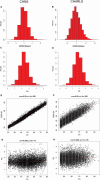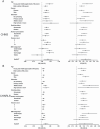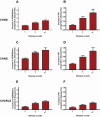Development and Validation of 2 Composite Aging Measures Using Routine Clinical Biomarkers in the Chinese Population: Analyses From 2 Prospective Cohort Studies
- PMID: 32946548
- PMCID: PMC8521780
- DOI: 10.1093/gerona/glaa238
Development and Validation of 2 Composite Aging Measures Using Routine Clinical Biomarkers in the Chinese Population: Analyses From 2 Prospective Cohort Studies
Abstract
Background: This study aimed to: (i) develop 2 composite aging measures in the Chinese population using 2 recent advanced algorithms (the Klemera and Doubal method and Mahalanobis distance); and (ii) validate the 2 measures by examining their associations with mortality and disease counts.
Methods: Based on data from the China Nutrition and Health Survey (CHNS) 2009 wave (N = 8119, aged 20-79 years, 53.5% women), a nationwide prospective cohort study of the Chinese population, we developed Klemera and Doubal method-biological age (KDM-BA) and physiological dysregulation (PD, derived from Mahalanobis distance) using 12 biomarkers. For the validation analysis, we used Cox proportional hazard regression models (for mortality) and linear, Poisson, and logistic regression models (for disease counts) to examine the associations. We replicated the validation analysis in the China Health and Retirement Longitudinal Study (CHARLS, N = 9304, aged 45-99 years, 53.4% women).
Results: Both aging measures were predictive of mortality after accounting for age and gender (KDM-BA, per 1-year, hazard ratio [HR] = 1.14, 95% confidence interval [CI] = 1.08, 1.19; PD, per 1-SD, HR = 1.50, 95% CI = 1.33, 1.69). With few exceptions, these mortality predictions were robust across stratifications by age, gender, education, and health behaviors. The 2 aging measures were associated with disease counts both cross-sectionally and longitudinally. These results were generally replicable in CHARLS although 4 biomarkers were not available.
Conclusions: We successfully developed and validated 2 composite aging measures-KDM-BA and PD, which have great potentials for applications in early identifications and preventions of aging and aging-related diseases in China.
Keywords: Aging measure; Chinese population; Klemera and Doubal method; Mortality; Physiological dysregulation.
© The Author(s) 2020. Published by Oxford University Press on behalf of The Gerontological Society of America. All rights reserved. For permissions, please e-mail: journals.permissions@oup.com.
Figures



Similar articles
-
Daytime napping, biological aging and cognitive function among middle-aged and older Chinese: insights from the China health and retirement longitudinal study.Front Public Health. 2023 Nov 17;11:1294948. doi: 10.3389/fpubh.2023.1294948. eCollection 2023. Front Public Health. 2023. PMID: 38045976 Free PMC article.
-
Associations between multiple metals exposure and biological aging: Evidence from the Dongfeng-Tongji cohort.Sci Total Environ. 2023 Feb 25;861:160596. doi: 10.1016/j.scitotenv.2022.160596. Epub 2022 Dec 2. Sci Total Environ. 2023. PMID: 36464054
-
Association of lifestyle with mortality and the mediating role of aging among older adults in China.Arch Gerontol Geriatr. 2022 Jan-Feb;98:104559. doi: 10.1016/j.archger.2021.104559. Epub 2021 Oct 13. Arch Gerontol Geriatr. 2022. PMID: 34741896
-
Common methods of biological age estimation.Clin Interv Aging. 2017 May 11;12:759-772. doi: 10.2147/CIA.S134921. eCollection 2017. Clin Interv Aging. 2017. PMID: 28546743 Free PMC article. Review.
-
Progress in biological age research.Front Public Health. 2023 Apr 12;11:1074274. doi: 10.3389/fpubh.2023.1074274. eCollection 2023. Front Public Health. 2023. PMID: 37124811 Free PMC article. Review.
Cited by
-
Methodological considerations regarding biomarker selection in the CHARLS-based study of serum uric acid and accelerated aging.J Nutr Health Aging. 2025 May 27;29(8):100588. doi: 10.1016/j.jnha.2025.100588. Online ahead of print. J Nutr Health Aging. 2025. PMID: 40435858 Free PMC article. No abstract available.
-
The relationship between serum uric acid and accelerated aging in middle-aged and older adults: a prospective cohort study based on CHARLS.J Nutr Health Aging. 2025 Mar;29(3):100488. doi: 10.1016/j.jnha.2025.100488. Epub 2025 Jan 15. J Nutr Health Aging. 2025. PMID: 39817994 Free PMC article.
-
Menopausal status, transition, and age at menopause with accelerated biological aging across multiple organ systems: findings from two cohort studies.BMC Med. 2025 Aug 6;23(1):461. doi: 10.1186/s12916-025-04223-7. BMC Med. 2025. PMID: 40770753 Free PMC article.
-
[Association between factors in life course and physiological dysregulation among the middle-aged and older population in Zhoushan city of Zhejiang province].Zhejiang Da Xue Xue Bao Yi Xue Ban. 2024 Jan 25;54(1):39-48. doi: 10.3724/zdxbyxb-2024-0168. Zhejiang Da Xue Xue Bao Yi Xue Ban. 2024. PMID: 39238396 Free PMC article. Chinese.
-
The association of proBNPage with manifestations of age-related cardiovascular, physical, and psychological impairment in community-dwelling older adults.Geroscience. 2021 Aug;43(4):2087-2100. doi: 10.1007/s11357-021-00381-7. Epub 2021 May 13. Geroscience. 2021. PMID: 33987773 Free PMC article.
References
Publication types
MeSH terms
Substances
Grants and funding
LinkOut - more resources
Full Text Sources
Medical

